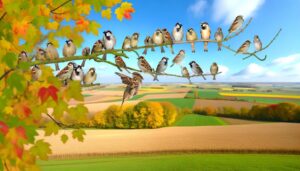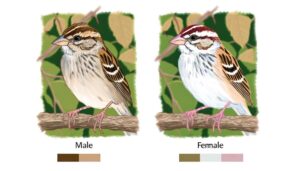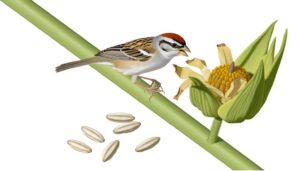How Did the Eurasian Tree Sparrow Come to North America?
The Eurasian Tree Sparrow migrated to North America in the 1870s due to intentional introduction by English immigrants. It found its new Midwestern environment, particularly Missouri and Illinois, conducive due to abundant food and suitable nesting sites in human-altered landscapes.
It adapted rapidly, demonstrating flexibility in diet and habitat selection, which promoted propagation in the new surroundings. Habitats in its original Palearctic range, spanning diverse ecosystems, likely prepared it for this adaptive success.
Continued exploration into its genetic diversity, migratory influences, and future population trends offers deeper understandings of this small bird's remarkable journey, and its impact on its adopted homeland.

Key Takeaways
- The Eurasian Tree Sparrow was introduced to North America by English immigrants in the 1870s.
- It quickly adapted to its new environment, exploiting abundant food and nesting sites in human-altered landscapes.
- The bird is most prevalent in the Midwest, particularly in Missouri and Illinois.
- The sparrow faces competition with native species, such as the House Sparrow, restricting its distribution.
- The lack of natural predators in North America contributes to its unhindered growth.
Origins of the Eurasian Tree Sparrow
Tracing back to its roots, the Eurasian Tree Sparrow originates from a broad range across the Palearctic, encompassing Europe, Asia, and parts of North Africa.
The species, Passer montanus, distinguishes itself through its rich, chestnut crown and nape, and black cheek patches. It's a robust bird, with a powerful, conical beak adapted for a diverse diet of seeds, grains, and insects.
Genetic studies show a high degree of genetic variation across the species' range, indicating a long evolutionary history.
The first recorded sightings in North America date back to the 1870s, when English immigrants introduced them into the United States. It's believed they sought to populate their new homes with familiar wildlife, thereby commencing the sparrow's North American journey.
Sparrow Habitats in Europe and Asia
The Eurasian Tree Sparrow's habitat, spanning across varied landscapes in Europe and Asia, is characterized by open woodlands, farmlands, and urban areas, providing ample opportunities for these birds to feed and breed. Adaptable to diverse ecosystems, they nest in tree cavities, cliffs, and buildings, subsisting on a diet mainly of seeds, fruits, and insects.
| Region | Landscape | Food Source |
|---|---|---|
| Europe | Open Woodlands | Seeds, Fruits |
| Europe | Farmlands | Insects, Seeds |
| Europe | Urban Areas | Human Discards, Insects |
| Asia | Diverse Ecosystems | Varied Diet |
| Asia | Urban Areas | Human Discards, Insects |
Each region presents unique opportunities and challenges for the sparrows, shaping their behavior and adaptations. This wide-ranging habitat and flexible diet have aided their survival and propagation across continents.
The Sparrow's Journey to North America
Despite their Eurasian roots, these adaptable sparrows have managed to extend their territory, successfully establishing a small but steady population in North America.
It's unclear exactly when they made this transatlantic journey, but genetic evidence suggests it was relatively recent. They're believed to have arrived in the mid-19th century, likely transported unintentionally by ships carrying grain and other goods.
Once in North America, they quickly adapted to their new environment. They found abundant food and nesting sites in human-altered landscapes, such as farms and urban areas. These sparrows also demonstrated remarkable resilience to North America's harsh winters, further cementing their successful establishment.
Today, they're most prevalent in the Midwest, particularly in Missouri and Illinois.
Factors Influencing Sparrow Migration
Several factors influence the migration patterns of Eurasian Tree Sparrows. Seasonal changes, such as the onset of winter, trigger migration as sparrows search for warmer climates. Food availability is essential; sparrows tend to migrate to regions abundant in seeds, their primary diet. They're also opportunistic eaters, adjusting their diet based on the food available.
Nesting sites also play a role. Sparrows prefer areas with hollow trees or buildings for nesting, often migrating to such habitats. Moreover, sparrows are influenced by photoperiod—the length of daylight and darkness—which impacts their breeding cycle and migration timing.
Arrival and Settlement in North America
The Eurasian Tree Sparrow's transatlantic journey to North America is a remarkable feat, considering the distance and environmental challenges.
Once in North America, the species began to establish itself, adapting to new conditions and habitats.
Their successful settlement is an intriguing case of resilience, adaptation, and survival in ornithology.
Sparrow's Transatlantic Journey
In the late 19th century, Eurasian Tree Sparrows made their transatlantic journey, finding a new abode on the shores of North America, specifically in the regions of St. Louis, Missouri. They were introduced intentionally by humans, an action that shaped their distribution across the continent.
| Year | Method of Introduction | Region |
|---|---|---|
| Late 1800s | Human-introduced | St. Louis, Missouri |
| Early 1900s | Spread naturally | Illinois, Iowa |
| Mid-1900s | Limited introduction | Other regions |
| Late 1900s | Natural dispersion | Midwest US |
| 2000s | Stable population | Specific areas |
The table above illustrates the sparrow's journey. While the bird's spread was initially due to human intervention, natural dispersal played a considerable role in later years, demonstrating the species' resilience and adaptability to unfamiliar environments.
Settlement and Adaptation
Upon their arrival in North America, Eurasian Tree Sparrows quickly adapted to their new environment, displaying an impressive ability to thrive in diverse habitats across the continent. They utilized both rural and urban areas, taking advantage of available food sources and shelter.
In rural landscapes, they nested in trees and shrubs, while in urban settings, they occupied buildings and other human-made structures. Adjustment to North American climates varied, with the species showing a particular resilience in temperate zones. Their diet also shifted to accommodate local food availability, incorporating a wide range of seeds, insects, and berries.
This adaptive behavior showcases the Eurasian Tree Sparrow's survival instinct and versatility, essential factors in their successful colonization of North America.
Adapting to New Environments
How has the Eurasian Tree Sparrow adapted to its new environments in North America, particularly in urban and suburban areas?
In response to significant environmental changes, the sparrow has shown remarkable ecological plasticity. It's adapted to urbanized landscapes by exploiting man-made structures for nesting, such as buildings and bridges.
The sparrow's diet, consisting of seeds, insects, and human food scraps, has further facilitated its survival in these regions. It's also proven resilient to colder North American climates by developing thicker plumage.
However, despite its adaptability, the species' expansion remains limited, which suggests that certain ecological or evolutionary constraints might be at play.
Further scientific research is needed to fully understand this bird's unique adaptation strategies.
Eurasian Tree Sparrow Vs House Sparrow
Despite sharing similar environments, the Eurasian Tree Sparrow and the House Sparrow exhibit distinct differences in behavior, physical characteristics, and ecological impacts.
The Eurasian Tree Sparrow, smaller and less aggressive than its counterpart, has a distinctive brown cap and black cheek spot, contrasting the House Sparrow's gray cap and white cheeks.
Behaviorally, the Eurasian species prefers rural habitats and forms smaller flocks, while the House Sparrow thrives in urban settings and forms larger, more dominant groups.
Ecologically, the Eurasian Tree Sparrow has less impact on native bird populations due to its less competitive nature. However, the House Sparrow, due to its aggressive behavior and adaptability, often outcompetes native birds for resources, leading to a negative impact on biodiversity.
Current Status of Eurasian Tree Sparrows
Currently, Eurasian Tree Sparrows are maintaining a stable population in their native regions, while their presence in North America remains limited and localized.
In the areas they inhabit, primarily Missouri and Illinois, they've adapted to rural and suburban environments, often nesting in man-made structures. These sparrows coexist well with native birds, displaying neither aggressive takeover tendencies nor causing significant ecological impact.
However, their distribution in North America is largely restricted to the vicinity of their initial introduction point in St. Louis, Missouri, showing little expansion over the decades. Recent studies suggest that this restricted distribution may be due to competition with native species, particularly the House Sparrow, and the limitations of suitable habitat.
The Eurasian Tree Sparrow's current status underscores its relative adaptability, yet limited dispersal capacity.
Future Predictions for the Species
Future predictions for the Eurasian Tree Sparrow in North America necessitate the thorough analysis of two main factors:
population growth trends and the impact of environmental changes on the species.
A detailed study of population growth trends will help predict the long-term survival and expansion possibilities of the species in this new habitat.
Concurrently, the environmental impact assessment will provide vital insights into how alterations in the climate and habitat may influence the species' longevity and adaptation strategies.
Population Growth Trends
Experts project a steady rise in the population of the Eurasian Tree Sparrow in North America, predicated on current trends and environmental factors. This bird species has shown remarkable resilience, adapting to a variety of habitats including urban areas.
The sparrow's robust multiplication rate coupled with its potential to exploit diverse food sources underpins this prediction. The species' lack of natural predators in the region contributes to its unhindered growth. However, it's worth noting that such predictions are based on current conditions, and unforeseen changes could affect population trends.
Measures to monitor and manage this population growth are essential to maintain ecological balance and protect local biodiversity. Future research will focus on the potential influence of climate change on these trends.
Environment Impact Assessment
Evaluating the potential environmental impact of the increasing Eurasian Tree Sparrow population in North America is a vital step in understanding the long-term implications for the region's ecosystem. Experts predict that the expansion of this species could disrupt local food chains, as these birds compete with native species for resources. Their presence might also lead to the spread of foreign diseases.
Conversely, the sparrows could contribute to the biodiversity of the region, potentially benefiting some ecosystems. Further research is required to precisely predict the future impact. It's important to monitor this situation closely, employing conservation strategies if necessary, to maintain ecological balance.
The fate of the North American ecosystem may be significantly influenced by this seemingly insignificant sparrow.
Conclusion
In the grand tapestry of nature, the Eurasian tree sparrow has woven its own path, from its origins in Europe and Asia to its new home in North America.
This small bird's resilience and adaptability have allowed it to thrive in diverse environments, despite the odds.
The story of the Eurasian tree sparrow's journey is a reflection of the unstoppable march of evolution and migration, forever altering the avian landscape.
Its future, like its past, is sure to be a fascinating tale.






